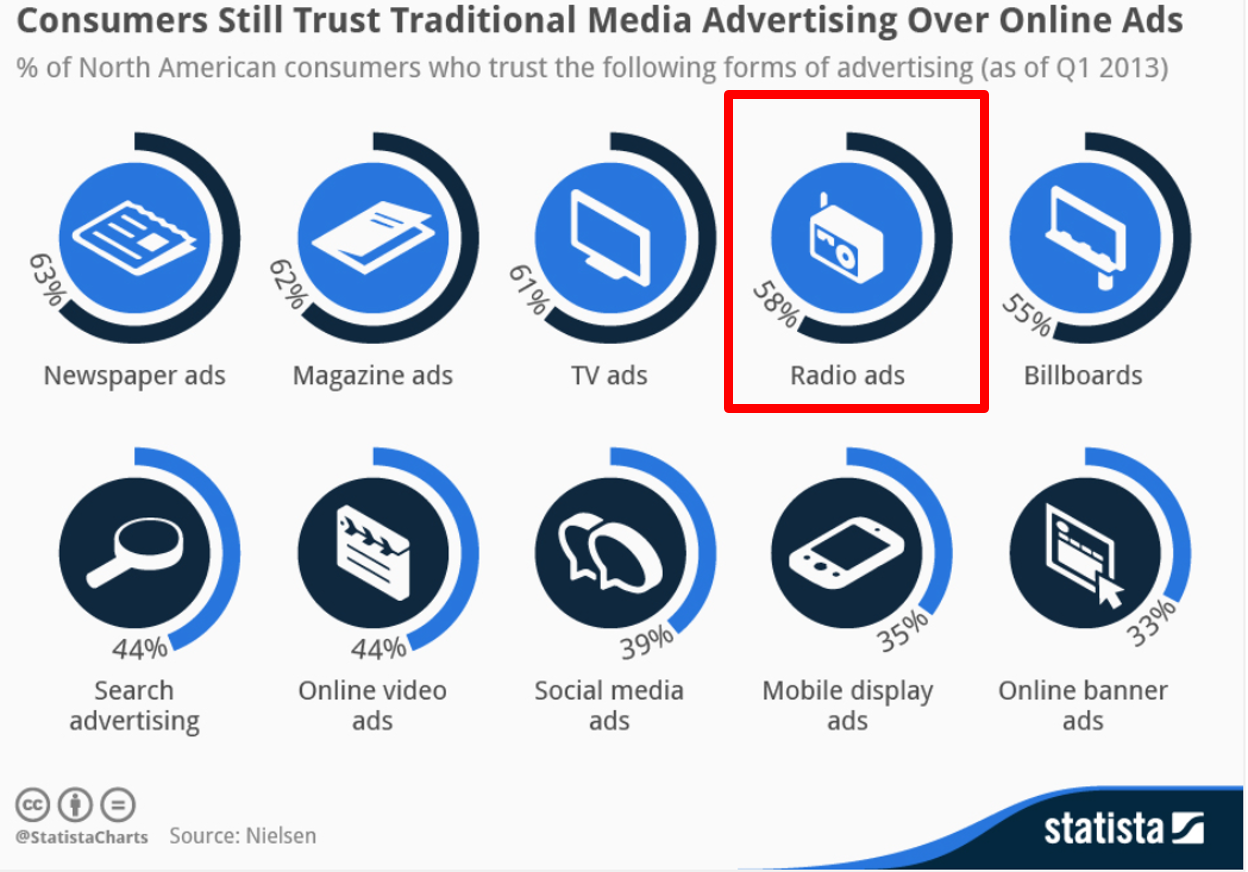
For veterans of the radio industry, today’s headline probably seems oxymoronic. But these days, the foundation of Internet advertising is being shaken to its core.
And the key issue revolves around trust.
A recent story in Wired – “YouTube’s Ad Problems Finally Blows Up In Google’s Face” – chronicles problems revolving around the placement of web advertising. Brands are cancelling their YouTube ad buys because their banners are randomly showing up in videos produced by extremists.
That lack of certainty goes to the heart of an issue that virtually all marketers care deeply about – where their ads run. The article discusses a Times of London investigative journalism piece that analyzed the placement of web ads sponsored by the British government. It turns out that a number of these ads ran ahead of videos produced by terrorist groups.
This is prompting an ad boycott from mainstream brands that include Pepsi and Wal-Mart. Google is taking steps to rein in control over their vast network, trying to provide a greater sense of security for advertisers, but the problem appears to be far from solved.
According to the Wired story (and most others), this problem isn’t isolated to Google (and YouTube). Last year, Facebook came clean about its own issues related to reporting ad performance to its marketing partners. And that has spawned more doubt about the reliability of web advertising. They quote an anonymous advertiser:
“When you’ve operated a marketplace, or owned and operated inventory that’s been so noncompliant with basic standards for so long, you can’t erase that mark overnight.”
It gets worse.
Last week, AdvertisingAge reported that JPMorgan Chase has drastically cut back its web ads as a result of spurious placement. In “Did JPMorgan Chase Just Start A Digital Advertising Revolution?” writer George Slefo reports the financial services giant cut the number of websites it advertises on from 400,000 down to just 5,000.
And surprisingly, its campaign effectiveness hasn’t changed much.
The lynchpin here may come down to web sources that simply don’t set high policies and standards. According to the AdAge story, Procter & Gamble is also considering ceasing ad spending on sites that aren’t up to snuff.
The odd part of the story is that while JPMorgan Chase originally made these moves to ensure the sanctity of their brand and their ads, they may have ended up discovering that web advertising simply isn’t as effective as once thought. Here’s the money quote from Jon Bond, co-chairman at The Shipyard, a digital agency:
“They were looking at brand safety and boom – the performance box pops out.”
And a mitigating factor may be the rush to programmatic advertising without hard and fast standards in place. The need for speed and convenience may have unwittingly created a problem where advertisers and web brands simply cannot keep up with the volume. The lack of a human review factor in the ad buying system is a missing element in the safety chain.
As a result, an ad for JPMorgan Chase could end up appearing on a site called “Hillary 4 Prison” – and that may have been the event that motivated their policy rethink.
Now move over to the radio landscape, an environment that has commercial issues of its own. But with basic policies in place and human traffic managers overseeing buys and placement, the chances for epic fails with radio buys are a lot less. Not to mention, most radio stations are not airing commercials for terrorist groups.
Perhaps that’s the reason why Nielsen and Statista discovered that when it comes to trust in advertising sources, radio is well ahead of the curve.
 This study is three years old, but it’s powerful, showing that among consumers, traditional media has an out-sized advantage over its digital competitors in the all-important trust department. Imagine how it would look today, in light of all the hubbub about “fake news” and digital ad placement nightmares.
This study is three years old, but it’s powerful, showing that among consumers, traditional media has an out-sized advantage over its digital competitors in the all-important trust department. Imagine how it would look today, in light of all the hubbub about “fake news” and digital ad placement nightmares.
What can radio sales departments do in order to capitalize on this shaky moment for digital ad sites?
- Make spot placement a priority – Offer reviews to advertisers so they’ll always know where their commercials are scheduled. This may take up some time, but an emphasis on credible placement is an issue, so why not benefit from radio’s obvious edge?
- Reinforce the human factor – In the same way your car salesman introduces you to the service manager when you take delivery on a new vehicle, make your traffic director a star. Introduce him/her to new clients, and provide a phone and contact information in case of emergencies.
- Communicate the station’s (or the company’s) commercial policy – What kinds of advertisers will never be on the air? Position that fact you scrutinize advertisers to ensure against “fake news” and bad actors trying to run ads.
- Emphasize your own digital efforts – Your station can offer new media opportunities via your stream, your app, podcasts, videos, social media, and other tools – that are safe. The difference is, humans control your ad and sponsor activity and you can guarantee safe placement.
For years, digital ad purveyors have been opportunistic in their efforts to reposition traditional media like radio. Among advertisers big and small, this is a conversation radio should be having.
On another note, noted researcher and marketer, Bill Moyes, created a campaign in 2015 – “Radio: The Power of Sound” – designed to make the case that radio’s ability to communicate a memorable message is unparalleled by other media. He is making the series available to anyone in radio at no charge. There is, however a fee of $120 per station ($210 in top 25 markets) to cover talent and rights fees. You can listen to a sample here. And market managers can contact Bill Moyes here.
- What Is It With Female Robot DJs? - April 30, 2025
- Why “Dance With Those Who Brung You” Should Be Radio’s Operating Philosophy In 2025 - April 29, 2025
- The Exponential Value of Nurturing Radio Superfans - April 28, 2025




Hear Spot Run: “Making every minute count…making it groovy.” – Spanky Our Gang.
Clark, Boston. http://www.broadcastideas.com
Now there’s a memory. Many thanks, Clark.
Radio’s trust factor/credibility – and revenue – client by client, will transcend that of competitors’, when we deliver what is obvious from Gord Borrell’s studies – what advertisers want, but most of us in radio – remarkably – do not deliver.
The answer to radio’s growth challenges is in delivering our advertisers 52 weeks of documented, measurable, attributable sales results, emanating from over-arching, client-focused (not station-centric) marketing strategies that put the client first – and not our own budgets. The rising tide created by the former is proven time and again, to result in the latter.
Radio has had the tools to both of these things for decades, but few bother to bless their advertisers by doing so, while digital competitors have passed us in the revenue race. Each of the above approaches produces more ad revenue per hour of prospecting, pitching, executing and servicing, than what the rest of the radio industry does with our status quo.
Serving up another 52 week reach schedule with three spec spots and a promotion, plus a side order of our “me too” digital marketing delights has its role, but this doesn’t solve radio’s years-old, inflation-adjusted, flat-lining revenue problem.
Delivering dollars and cents to our advertisers’ top lines is much more fun and makes us all much more money – what’s stopping all of us from doing this? The only way to radical revenue growth is to do that which is radically different from the crowd; with those systems, strategies and tactics proven to reward our advertisers – and us – with the 52 weeks of quantifiable revenue growth we all need.